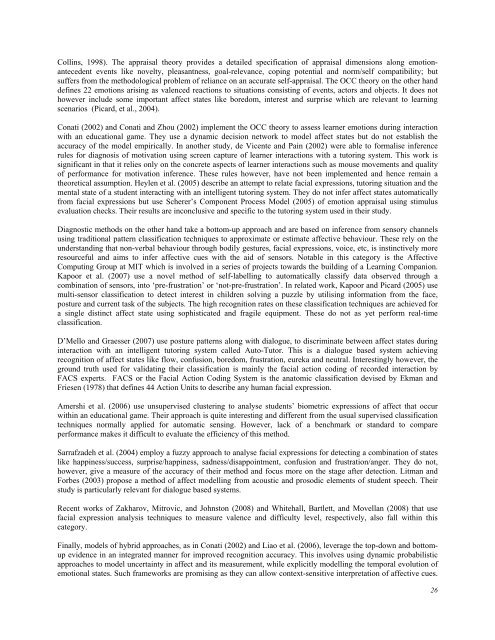October 2011 Volume 14 Number 4 - Educational Technology ...
October 2011 Volume 14 Number 4 - Educational Technology ...
October 2011 Volume 14 Number 4 - Educational Technology ...
You also want an ePaper? Increase the reach of your titles
YUMPU automatically turns print PDFs into web optimized ePapers that Google loves.
Collins, 1998). The appraisal theory provides a detailed specification of appraisal dimensions along emotionantecedent<br />
events like novelty, pleasantness, goal-relevance, coping potential and norm/self compatibility; but<br />
suffers from the methodological problem of reliance on an accurate self-appraisal. The OCC theory on the other hand<br />
defines 22 emotions arising as valenced reactions to situations consisting of events, actors and objects. It does not<br />
however include some important affect states like boredom, interest and surprise which are relevant to learning<br />
scenarios (Picard, et al., 2004).<br />
Conati (2002) and Conati and Zhou (2002) implement the OCC theory to assess learner emotions during interaction<br />
with an educational game. They use a dynamic decision network to model affect states but do not establish the<br />
accuracy of the model empirically. In another study, de Vicente and Pain (2002) were able to formalise inference<br />
rules for diagnosis of motivation using screen capture of learner interactions with a tutoring system. This work is<br />
significant in that it relies only on the concrete aspects of learner interactions such as mouse movements and quality<br />
of performance for motivation inference. These rules however, have not been implemented and hence remain a<br />
theoretical assumption. Heylen et al. (2005) describe an attempt to relate facial expressions, tutoring situation and the<br />
mental state of a student interacting with an intelligent tutoring system. They do not infer affect states automatically<br />
from facial expressions but use Scherer’s Component Process Model (2005) of emotion appraisal using stimulus<br />
evaluation checks. Their results are inconclusive and specific to the tutoring system used in their study.<br />
Diagnostic methods on the other hand take a bottom-up approach and are based on inference from sensory channels<br />
using traditional pattern classification techniques to approximate or estimate affective behaviour. These rely on the<br />
understanding that non-verbal behaviour through bodily gestures, facial expressions, voice, etc, is instinctively more<br />
resourceful and aims to infer affective cues with the aid of sensors. Notable in this category is the Affective<br />
Computing Group at MIT which is involved in a series of projects towards the building of a Learning Companion.<br />
Kapoor et al. (2007) use a novel method of self-labelling to automatically classify data observed through a<br />
combination of sensors, into ‘pre-frustration’ or ‘not-pre-frustration’. In related work, Kapoor and Picard (2005) use<br />
multi-sensor classification to detect interest in children solving a puzzle by utilising information from the face,<br />
posture and current task of the subjects. The high recognition rates on these classification techniques are achieved for<br />
a single distinct affect state using sophisticated and fragile equipment. These do not as yet perform real-time<br />
classification.<br />
D’Mello and Graesser (2007) use posture patterns along with dialogue, to discriminate between affect states during<br />
interaction with an intelligent tutoring system called Auto-Tutor. This is a dialogue based system achieving<br />
recognition of affect states like flow, confusion, boredom, frustration, eureka and neutral. Interestingly however, the<br />
ground truth used for validating their classification is mainly the facial action coding of recorded interaction by<br />
FACS experts. FACS or the Facial Action Coding System is the anatomic classification devised by Ekman and<br />
Friesen (1978) that defines 44 Action Units to describe any human facial expression.<br />
Amershi et al. (2006) use unsupervised clustering to analyse students’ biometric expressions of affect that occur<br />
within an educational game. Their approach is quite interesting and different from the usual supervised classification<br />
techniques normally applied for automatic sensing. However, lack of a benchmark or standard to compare<br />
performance makes it difficult to evaluate the efficiency of this method.<br />
Sarrafzadeh et al. (2004) employ a fuzzy approach to analyse facial expressions for detecting a combination of states<br />
like happiness/success, surprise/happiness, sadness/disappointment, confusion and frustration/anger. They do not,<br />
however, give a measure of the accuracy of their method and focus more on the stage after detection. Litman and<br />
Forbes (2003) propose a method of affect modelling from acoustic and prosodic elements of student speech. Their<br />
study is particularly relevant for dialogue based systems.<br />
Recent works of Zakharov, Mitrovic, and Johnston (2008) and Whitehall, Bartlett, and Movellan (2008) that use<br />
facial expression analysis techniques to measure valence and difficulty level, respectively, also fall within this<br />
category.<br />
Finally, models of hybrid approaches, as in Conati (2002) and Liao et al. (2006), leverage the top-down and bottomup<br />
evidence in an integrated manner for improved recognition accuracy. This involves using dynamic probabilistic<br />
approaches to model uncertainty in affect and its measurement, while explicitly modelling the temporal evolution of<br />
emotional states. Such frameworks are promising as they can allow context-sensitive interpretation of affective cues.<br />
26

















